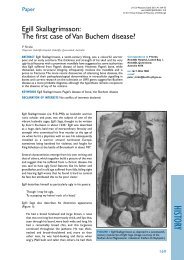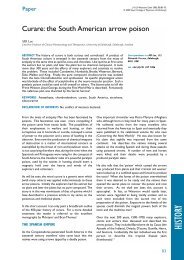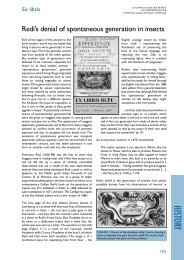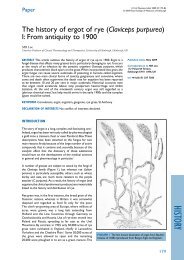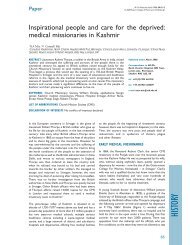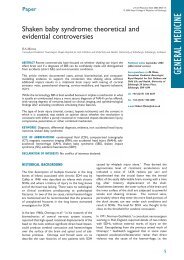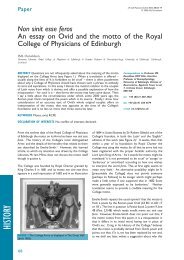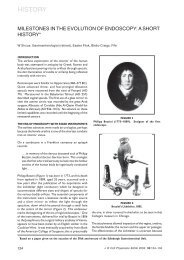The Solanaceae II: The mandrake (Mandragora officinarum); in ...
The Solanaceae II: The mandrake (Mandragora officinarum); in ...
The Solanaceae II: The mandrake (Mandragora officinarum); in ...
You also want an ePaper? Increase the reach of your titles
YUMPU automatically turns print PDFs into web optimized ePapers that Google loves.
HISTORY<br />
MR Lee<br />
In 1889, Ahrens isolated an alkaloid from <strong>Mandragora</strong><br />
which he called ‘mandragor<strong>in</strong>e’. However, <strong>in</strong> 1901 Thoms<br />
and We<strong>in</strong>zel demonstrated that Ahren’s compound was <strong>in</strong><br />
fact a mixture of hyoscyam<strong>in</strong>e and hyosc<strong>in</strong>e together with<br />
a small amount of a third alkaloid for which they reta<strong>in</strong>ed<br />
the name mandragor<strong>in</strong>e. Despite this flurry of <strong>in</strong>terest <strong>in</strong><br />
the chemical constituents of <strong>mandrake</strong>, it was too late for<br />
the development of the plant. As we shall see <strong>in</strong> the next<br />
two articles <strong>in</strong> this series, hyosc<strong>in</strong>e and atrop<strong>in</strong>e were<br />
already characterised chemically by 1900 and com<strong>in</strong>g <strong>in</strong>to<br />
therapeutic use. Indeed they would be employed <strong>in</strong><br />
murder and attempted murder.<br />
FINAL THOUGHTS<br />
284<br />
‘<strong>The</strong> phantom shapes – oh touch not them –<br />
That appals the maiden’s sight,<br />
Lurk <strong>in</strong> the fleshy <strong>mandrake</strong>’s stem,<br />
That shrieks when pluckt at night!’<br />
Lalla Rookh<br />
by Thomas Moore (1779–1852)<br />
<strong>The</strong> history of the <strong>mandrake</strong> as we have seen, is<br />
<strong>in</strong>trigu<strong>in</strong>g, curious and exotic. From the mists of antiquity<br />
its association with magic, demons and fertility ensured<br />
that it was regarded with fear, loath<strong>in</strong>g and fasc<strong>in</strong>ation.<br />
How did this come about? A plant that could produce<br />
deep sleep (and sometimes delirium and halluc<strong>in</strong>ations)<br />
and which also glowed <strong>in</strong> the dark was obviously very<br />
special. As madness <strong>in</strong> the Christian tradition was often<br />
ascribed to possession of the m<strong>in</strong>d by an evil spirit, so<br />
the <strong>mandrake</strong> was the ‘home’ of a similar malevolent<br />
be<strong>in</strong>g, fiend or genie. Moreover, the power of the myth<br />
was strengthened by the fact that the roots, either<br />
naturally, or after carv<strong>in</strong>g, resembled closely the<br />
appearance of a man (or a woman).<br />
<strong>The</strong> scene was thus set for an illiterate credulous people<br />
to <strong>in</strong>vest the <strong>mandrake</strong> with all sorts of magical powers<br />
both evil and beneficial, and to develop complex rituals <strong>in</strong><br />
order to harvest the plant without harm<strong>in</strong>g themselves<br />
or <strong>in</strong>terfer<strong>in</strong>g with its potency. Indeed the plant became<br />
so valuable that, <strong>in</strong> Europe, a shortage resulted and this<br />
led on to other roots be<strong>in</strong>g used such as the black and<br />
white brionies. <strong>The</strong>se were passed off on the<br />
unsuspect<strong>in</strong>g public as the genu<strong>in</strong>e article. Mandrake<br />
became so prized as a precious heirloom that specific<br />
REFERENCES<br />
1 Shakespeare W. Romeo and Juliet Act IV, Scene 4 v.45–7.<br />
2 Chevalier A. <strong>Mandragora</strong> <strong>offic<strong>in</strong>arum</strong>. In: Encyclopedia of Medic<strong>in</strong>al<br />
Plants. London: Dorl<strong>in</strong>g K<strong>in</strong>dersley; 1996; 230.<br />
3 Greenblatt RB. <strong>The</strong> Mandrake In: Search the Scriptures. Lancashire:<br />
Parthenon Press; 1985; 12–14.<br />
arrangements were made as to its <strong>in</strong>heritance. Around<br />
1600, the situation changed materially when the up and<br />
com<strong>in</strong>g herbalists poured scorn on the old beliefs whilst<br />
still recommend<strong>in</strong>g the root for certa<strong>in</strong> specific problems.<br />
F<strong>in</strong>ally, the advent of nitrous oxide, ether and chloroform<br />
put paid to its use <strong>in</strong> anaesthesia. Further, the isolation of<br />
atrop<strong>in</strong>e and hyosc<strong>in</strong>e from other sources ended any<br />
other possible therapeutic uses.<br />
Of the four members of the <strong>Solanaceae</strong> to be described<br />
<strong>in</strong> this short series of articles, the other three have found<br />
a use either as a foodstuff (the potato) or as a source of<br />
medic<strong>in</strong>al substances (henbane and deadly nightshade).<br />
Nevertheless the <strong>mandrake</strong> should be remembered as a<br />
powerful example of how gullible the general public can<br />
be when presented with phenomena that seem<br />
<strong>in</strong>explicable at the time.<br />
In clos<strong>in</strong>g we should perhaps remember the words of<br />
John Ray, the great 17th century botanist, who wrote:<br />
‘If I am to be quite honest there are many po<strong>in</strong>ts on<br />
these subjects still open to doubt; questions can be<br />
raised which I confess I am not competent to solve<br />
or disentangle; this is not because they have not got<br />
def<strong>in</strong>ite natural explanations but because I am<br />
ignorant of them.’<br />
In the twenty first century the man <strong>in</strong> the street is still<br />
credulous, as is illustrated by the rapid growth of<br />
alternative therapies such as colonic lavage, reflexology<br />
and crystal treatment. Neither can the medical<br />
profession be altogether excluded from this besett<strong>in</strong>g<br />
cont<strong>in</strong>u<strong>in</strong>g frailty of the human condition.<br />
ACKNOWLEDGEMENTS<br />
It is a pleasure to recommend the book on the Mystic<br />
Mandrake written by Thompson <strong>in</strong> 1934 who was, at that<br />
time, Honorary Curator of the Historical Collection of<br />
the Museum of the Royal College of Surgeons of England<br />
<strong>in</strong> London. This volume is an essential source for anyone<br />
<strong>in</strong>terested <strong>in</strong> the <strong>mandrake</strong> (Reference 5).<br />
I would also like to thank the library at the Royal College<br />
of Physicians <strong>in</strong> Ed<strong>in</strong>burgh, <strong>in</strong> particular Mr John Dallas, for<br />
help with the figures. My thanks are also due to my<br />
<strong>in</strong>defatiguable secretary Mrs May Gibb for her cont<strong>in</strong>u<strong>in</strong>g<br />
help over the years.<br />
4 <strong>The</strong> Authorised Version of the K<strong>in</strong>g James Bible. Genesis Chapter<br />
XXX v.14–19.<br />
5 Thompson CJS. <strong>The</strong> Mystic Mandrake In: Ancient Greece. London:<br />
Rider and Co; 1934; 51–60.<br />
6 As above, Chapter IX. <strong>The</strong> Romans and Mandrake, pp.97–103.<br />
7 As above, Chapter X. <strong>The</strong> Mandrake <strong>in</strong> Brita<strong>in</strong> – Anglo-Saxon<br />
times – Traditions <strong>in</strong> England and Wales, pp.107–116.<br />
J R Coll Physicians Ed<strong>in</strong>b 2006; 36:278–285<br />
© 2006 RCPE



